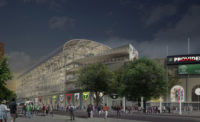When the Bull Run Hydroelectric project was built in the early 1900s, it was considered a feat of engineering and skilled construction. Sited in what was then a remote wilderness about 35 miles east of Portland, Ore., the project comprised an integrated network of construction and engineering : dams on the Sandy and Little Sandy Rivers, more than three miles of canals and tunnels, a wooden box flume to transport water nearly three miles to the man-made Roslyn Lake reservoir and a powerhouse on the banks of the Bull Run River.
Following design by Mount Hood Railway and Power Co., its subsidiary Mount Hood Construction Co. began construction in 1909. The job was completed in 1912 by Portland Railway Light & Power, a predecessor to Portland General Electric (PGE). The power station would serve Portland’s growing population for decades, but in 1999, after nearly 94 years of operation, PGE determined that the environmental costs associated with relicensing were too high to justify continued operation. In 2007, PGE began decommissioning. Restoring the Sandy and Little Sandy Rivers to their original flows was a key component.
The Bull Run powerhouse, a symbolic relic of the region’s early 20th century urbanization, was decommissioned in 2008 with the dams removed to improve the rivers for fish migration. The remaining facilities would have been demolished if not for the efforts of Portland-based Powerhouse Re Gen, a small partnership who bought the property from PGE to preserve the historical powerhouse.
“The site has an incredible story to tell,” said Re Gen partner Jeff Joslin, a planning and architectural consultant and former land use supervisor for the City of Portland. (In October, Joslin took a job in San Francisco as the director of current planning for the city planning department.) For Bull Run, he said, “our intent is for the powerhouse to play an interpretive role, telling of the early development of Portland, the industrialization of these rivers, and the importance of hydroelectric power in the region.”
Historian George Kramer, who PGE hired to prepare Bull Run’s determination of eligibility application for the National Park Service’s National Register of Historic Places, said the project was initially driven by the need to supply electric power for Portland’s developing trolley system. “Because of the magnitude of river systems in the Pacific Northwest, hydroelectricity represented the easiest and most cost-effective source of power available,” Kramer said. “Even today, the majority of electricity in the Pacific Northwest is hydropower.”
During the era leading up to construction of the project, the environment was “superheated in terms of the competition to bring hydroelectric power online,” and “financing these types of ventures was considered extremely risky,” according to Joslin.
But perhaps the greatest challenge facing those building the powerhouse more than a century ago was the project site’s remoteness. “In order to overcome the shear inaccessibility of the location, a railroad was constructed directly to the site,” Joslin said. “The powerhouse facility was designed so that trains coming from Portland could literally pass right through the transformer building and offload heavy equipment. The train stayed operational and was used to service the powerhouse over time.”
Re Gen is still unsure of the best use for the powerhouse site and its associated facilities. The deal included the original machine shop, 100 acres of surrounding land, recreational structures, and a former historic elementary school. The partners are continuing to explore a number of possibilities. “The facility and structures are incredibly intact and could be used to support a number of adaptive reuses,” Joslin said. “Propositions thus far have included an outdoor school, a blacksmith shop, and even a brewery. The building’s aesthetic qualities have also attracted interest for prospective music video, photo, and movie shoots. In fact, the NBC series Grimm filmed last season’s final show at the site’s transformer building.”
In late September, Powerhouse Re Gen held an open house celebrating the powerhouse’s 100-year anniversary.






Post a comment to this article
Report Abusive Comment